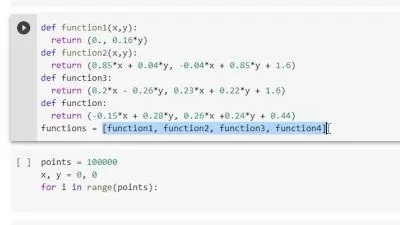Energy Geopolitics using Data Science
The Algorithmic Economist (PhD)
4:36:23
Description
Energy Geopolitics, Geospatial Data Visualization, Data Analysis in Python
What You'll Learn?
- A great course that uses python! Learn the details from an expert!
- Use Q&A forum for your questions!
- The course is regularly updated. Visit every 6-12 months to view the updated material!
- Lean how to design and visualize pipelines and interconnectors on maps using Python and geospatial data analysis tools.
- Learn to install and use Python and essential packages like Geopandas, with guidance on overcoming common challenges.
- Learn many geolocation techniques in Python, from creating basic maps to advanced tasks such as plotting interconnectors and updating territories.
- Practical applications include mapping real-world energy infrastructure projects in the Eastern Mediterranean, Europe, and Asia.
Who is this for?
What You Need to Know?
More details
Description1. AFTERÂ YOUÂ BUYÂ THISÂ COURSE, VISITÂ OFTENÂ TOÂ DOWNLOADÂ THEÂ UPDATEDÂ CONTENT
IÂ UPDATEÂ THEÂ CONTENTÂ EVERYÂ 6-12 MONTHS!Â
2. WHATÂ THISÂ COURSE ISÂ ABOUT
This course offers a comprehensive exploration of geolocation techniques in Python, covering a range of mapping tasks from basic to complex. Key topics include plotting interconnectors and updating territorial boundaries, providing students with practical skills applicable to real-world scenarios.
The course stands out by applying these technical skills to map actual energy infrastructure projects across diverse regions, including the Eastern Mediterranean, North West Europe, North East Europe, and Asia. This practical approach bridges the gap between theoretical knowledge and real-world application, making the learning experience more relevant and engaging.
A unique aspect of this course is its integration of technical implementation with geopolitical analysis. This combination offers students not just programming skills, but also valuable insights into global energy infrastructure development, enhancing their understanding of the broader context in which these technical skills are applied.
The course is designed to appeal to a specific audience, targeting professionals in the energy and defence industries, as well as geopolitics enthusiasts. This focus allows for tailored content that directly addresses the needs and interests of these groups.
Importantly, the course requires no prerequisites and assumes no prior experience, making it accessible to beginners while still offering valuable content for more experienced individuals. The regular updates to the course material ensure that students have access to the most current information and techniques, reflecting the dynamic nature of both the technology and the geopolitical landscape.
This unique combination of technical skills, real-world applications, and geopolitical insights makes the course an invaluable resource for anyone looking to understand and engage with the complex world of global energy infrastructure. By providing both the tools to analyze and map these systems, and the context to understand their significance, the course equips students with a powerful skillset applicable in various professional and academic settings.
Who this course is for:
- Geopolitical Researchers focusing on the geopolitical implications of energy infrastructure, particularly in strategic areas like the Eastern Mediterranean, Europe, and Asia.
- Data Scientists who want to specialize in geospatial data visualization and its applications in the energy sector.
- Policy Makers and Consultants involved in energy policy, infrastructure planning, or consulting who need to understand and communicate complex geographical data related to energy systems.
- Professionals working in the energy industry who need to visualize and analyze pipeline networks and interconnectors across different regions.
- Geographic Information System (GIS) professionals looking to expand their toolkit with Python-based solutions for mapping energy infrastructure.
- Reporters and journalists specializing in energy, geopolitics, or data-driven storytelling who want to create compelling, data-backed visualizations of energy infrastructure.
- Scholars and researchers studying the historical development of energy infrastructure, its impact on geopolitics, and its role in shaping modern societies.
1. AFTERÂ YOUÂ BUYÂ THISÂ COURSE, VISITÂ OFTENÂ TOÂ DOWNLOADÂ THEÂ UPDATEDÂ CONTENT
IÂ UPDATEÂ THEÂ CONTENTÂ EVERYÂ 6-12 MONTHS!Â
2. WHATÂ THISÂ COURSE ISÂ ABOUT
This course offers a comprehensive exploration of geolocation techniques in Python, covering a range of mapping tasks from basic to complex. Key topics include plotting interconnectors and updating territorial boundaries, providing students with practical skills applicable to real-world scenarios.
The course stands out by applying these technical skills to map actual energy infrastructure projects across diverse regions, including the Eastern Mediterranean, North West Europe, North East Europe, and Asia. This practical approach bridges the gap between theoretical knowledge and real-world application, making the learning experience more relevant and engaging.
A unique aspect of this course is its integration of technical implementation with geopolitical analysis. This combination offers students not just programming skills, but also valuable insights into global energy infrastructure development, enhancing their understanding of the broader context in which these technical skills are applied.
The course is designed to appeal to a specific audience, targeting professionals in the energy and defence industries, as well as geopolitics enthusiasts. This focus allows for tailored content that directly addresses the needs and interests of these groups.
Importantly, the course requires no prerequisites and assumes no prior experience, making it accessible to beginners while still offering valuable content for more experienced individuals. The regular updates to the course material ensure that students have access to the most current information and techniques, reflecting the dynamic nature of both the technology and the geopolitical landscape.
This unique combination of technical skills, real-world applications, and geopolitical insights makes the course an invaluable resource for anyone looking to understand and engage with the complex world of global energy infrastructure. By providing both the tools to analyze and map these systems, and the context to understand their significance, the course equips students with a powerful skillset applicable in various professional and academic settings.
Who this course is for:
- Geopolitical Researchers focusing on the geopolitical implications of energy infrastructure, particularly in strategic areas like the Eastern Mediterranean, Europe, and Asia.
- Data Scientists who want to specialize in geospatial data visualization and its applications in the energy sector.
- Policy Makers and Consultants involved in energy policy, infrastructure planning, or consulting who need to understand and communicate complex geographical data related to energy systems.
- Professionals working in the energy industry who need to visualize and analyze pipeline networks and interconnectors across different regions.
- Geographic Information System (GIS) professionals looking to expand their toolkit with Python-based solutions for mapping energy infrastructure.
- Reporters and journalists specializing in energy, geopolitics, or data-driven storytelling who want to create compelling, data-backed visualizations of energy infrastructure.
- Scholars and researchers studying the historical development of energy infrastructure, its impact on geopolitics, and its role in shaping modern societies.
User Reviews
Rating
The Algorithmic Economist (PhD)
Instructor's Courses
Udemy
View courses Udemy- language english
- Training sessions 28
- duration 4:36:23
- Release Date 2024/11/17









